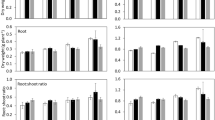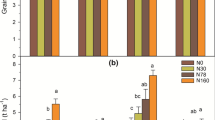Abstract
The management of subsurface soil acidity remains a challenge. We tested the ability of calcium nitrate fertilization to force net anion uptake by wheat within acidic subsurface layers and hence its ability to increase, or at least maintain, soil pH within the acidic layer. The trials were conducted at two field sites: the moderately acidic site ran for 3 years (2006–08) while the trial at the most acidic site was conducted for 2 years (2006–07). Five treatments (nitrogen form and application method) were compared. Uptake efficiency of nitrogen (N) as measured by 15N was similar (at ~40 to 70%) for both urea and nitrate sources at both sites. The urea source acidified the soils (up to 0.2 pH in 3 years) whilst the nitrate form resulted in increases in soil pH (up to 0.3 pH). The increases in pH were of a similar magnitude to the acidification rate measured in a nearby long-term trial. The dry matter production and grain yield in our trials were compromised by the decade long drought in our region, so the work should be repeated during wetter seasons. Calcium nitrate fertilization is a useful tool for at least maintaining soil pH, and even reversing soil acidification, in acidic subsurface soil layers.



Similar content being viewed by others
References
Adams F, Pearson RW (1969) Neutralising soil acidity under bermudagrass sod. Soil Sci Soc Am Proc 33:737–742
Bolan NS, Hedley MJ, White RE (1991) Processes of soil acidification during nitrogen cycling with emphasis on legume based pastures. Plant Soil 134:53–63
Conyers MK, Heenan DP, Poile GJ, Cullis BR, Helyar KR (1996) Influence of dryland agricultural management practices on the acidification of a soil profile. Soil Tillage Res 37:127–141
Cregan PD, Hirth JR, Conyers MK (1989) Amelioration of soil acidity by liming and other amendments. In: Robson AD (ed) Soil acidity and plant growth. Academic, Sydney, pp 205–264
FAO-UNESCO (1974) Soil map of the world vol 1. Legend. UNESCO, Paris
Gillman GP, Sumpter EA (1986) Modification to the compulsive exchange method for measuring exchange characteristics of soils. Aust J Soil Res 24:61–66
Isbell RF (2002) The Australian soil classification. CSIRO Publishing, Collingwood
Jarvis SC, Robson AD (1983a) A comparison of cation/anion balance of ten cultivars of Trifolium subterraneum L. and their effects on soil acidity. Plant Soil 75:235–243
Jarvis SC, Robson AD (1983b) The effects of nitrogen nutrition of plants on the development of acidity in Western Australian soils. I. Effects with subterranean clover grown under leaching conditions. Aust J Agric Research 34:341–353
Jarvis SC, Robson AD (1983c) The effects of nitrogen nutrition of plants on the development of acidity in Western Australian soils. II. Effects of differences in cation/anion balance between plant species grown under non-leaching conditions. Aust J Agric Research 34:355–365
Noble AD, Suzuki S, Soda W, Ruaysoongnern S, Berthelsen S (2008) Soil acidification and carbon storage in fertilized pastures of Northeast Thailand. Geoderma 144:248–255
Rayment GE, Higginson FR (1992) Australian laboratory handbook of soil and water chemical methods. Inkata Press, Melbourne
Sargeant M, Sale P, Tang C (2006) Salt priming improves establishment of Distichlis spicata under saline conditions. Aust J Agric Res 57:1259–1265
Storrier RR (1965) The influence of water on wheat yield, plant nitrogen uptake, and soil mineral nitrogen concentration. Aust J Exp Agric Anim Husb 5:310–316
Tang C, Rengel Z (2003) Role of plant cation/anion uptake ratio in soil acidification. In: Rengel Z (ed) Handbook of soil acidity. Marcel Dekker, New York, pp 57–81
Tang C, Conyers MK, Nuruzzaman M, Poile GJ, Liu DL (2011) Biological amelioration of subsoil acidity through managing nitrate uptake by wheat crops. Plant Soil 338:383–397
Weligama C, Sale PWG, Conyers MK, Liu DL, Tang C (2010) Nitrate leaching stimulates subsurface root growth of wheat and increases rhizosphere alkalisation in a highly acidic soil. Plant Soil 328:119–132
Acknowledgement
We thank Ms Giang Nguyen and Mr James Kellerman for technical assistance, and Australian Research Council (LP0562504) and NSW Department of Primary Industries for financial support.
Author information
Authors and Affiliations
Corresponding author
Additional information
Responsible Editor: Peter J. Gregory.
Rights and permissions
About this article
Cite this article
Conyers, M.K., Tang, C., Poile, G.J. et al. A combination of biological activity and the nitrate form of nitrogen can be used to ameliorate subsurface soil acidity under dryland wheat farming. Plant Soil 348, 155–166 (2011). https://doi.org/10.1007/s11104-011-0827-6
Received:
Accepted:
Published:
Issue Date:
DOI: https://doi.org/10.1007/s11104-011-0827-6




